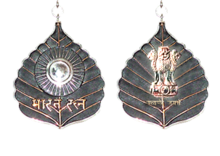|
Orders, decorations, and medals of India
The Indian honours system is the system of awards given to individuals for a variety of services to the Republic of India. The categories of awards are as follows: Civilian awardsBharat Ratna
Padma awardsPadma Awards[3] were instituted in the year 1954. Except for brief interruptions during the years 1978 to 1979 and 1993 to 1997, these awards have been announced every year on Republic Day. The award is given in three categories: Padma Vibhushan, Padma Bhushan and Padma Shri, in decreasing order of precedence.
Unlike national honours, the Padma awards do not include cash allowances, benefits, or special concessions in rail/air travel.[4] The Supreme Court of India, Balaji Raghavan v. Union of India, (1996)[5] while the Bharat Ratna and the Padma awards do not come under the definition of "titles" under Article 18 of Fundamental Rights in India, no titles or honorifics are associated with the Bharat Ratna or any of the Padma awards; awardees cannot use them or their initials as suffixes, prefixes or pre- and post-nominals attached to the awardee's name. This includes any such use on letterheads, invitation cards, posters, books etc. In the case of any misuse, the awardee will forfeit the award, and he or she is cautioned against any such misuse upon receiving the honour.[6]
Selection processThese awards seek to recognize work of any distinction, and is given for distinguished and exceptional achievements/service in all fields of activities/disciplines, such as art, literature and education, sports, medicine, social work, science and engineering, public affairs, civil service, trade and industry, etc. All persons without distinction of race, occupation, position or sex are eligible for these awards. In 2015, the government decided to end the practice of ministers recommending names for Padma awards and replaced it with any Indian citizen recommending a person for Padma awards online. The government said that this was done with the belief that every citizen has something to contribute to the nation and that contribution should be integrated with the country's growth. Accordingly, several hitherto unknown citizens were awarded Padma awards in 2017. The role of the state governments was also minimised.[7][8][9] Annulment of awardsWhile there are no specific criteria for withdrawing a Padma award, the President of India, per the awards' statutes, may cancel and annul any award in the case of any misconduct committed by the recipient. At least three awards of the Padma Shri have been so annulled, twice in 1958 for recipients residing in the state of Punjab and once in 1974 for a recipient residing in the state of Gujarat.[10] Military awardsSince 11 July 2019, the Indian Army allows close relatives of deceased military personnel to wear their medals on the right side of the chest while attending homage ceremonies at war memorials, cemeteries and funerals.[11] Wartime gallantry awardsEstablished on 26 January 1950 with retrospective effect from 15 August 1947.
Peacetime gallantry awardsThese awards were instituted on 4 January 1952. These awards were renamed on 27 January 1967 as Ashoka Chakra, Kirti Chakra and Shaurya Chakra from Ashoka Chakra (Class I), Ashoka Chakra (Class II) and Ashoka Chakra (Class III) respectively. Wartime/peacetime service awardsWartime distinguished awardsPeacetime distinguished awardsThey were established on January 26, 1960. Other national awards
Women
Children
Science and technology awardsMedicine awards
Literature awards
Sports awardsAdventure awardsCinema and arts
Performing artsSangeet Natak Akademi is the national academy for music, dance, and drama, and is considered the apex body for performing arts in India. Particular awardsPolice awards
Home Guard and Civil Defence awards
Fire Services awards
Correctional Services awards
Coast Guard awards
Bravery
Corporate AwardsNational Corporate Social Responsibility Awards are given by the President of India. These awards have been instituted by the Ministry of Corporate Affairs. Awards are given in 20 different sub-categories. Overseas Indian Awards
See also
References
External linksWikimedia Commons has media related to Orders, decorations and medals of India. |
||||||||

